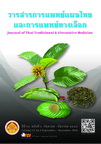Traditional Use of Kratom (Mitragyna speciosa Korth) among Folk Healers in Southern Thailand
Main Article Content
Abstract
Rationale and objective: In Thailand, kratom (Mitragyna speciosa Korth) has been traditionally used as medicine by folk healers. To confirm whether the use is in accordance with Thai traditional medical knowledge or not, this study aimed to (1) review traditional medicine formulas of kratom from traditional Thai medical scriptures and (2) explore the therapeutic use of kratom among folk healers in southern Thailand.
Methodology: This study was a mixed method research composed of: (1) documentary research based on six traditional Thai medical scriptures and (2) qualitative research done among folk healers by means of in-depth interview and focus group discussion. The key informants were 39 folk healers in southern Thailand who had had experiences in using kratom as medicine.
Results: There were eight traditional medicine formulas containing kratom in traditional Thai medical scriptures: (1) ya prasa kratom, (2) ya klom arom sut 1, (3) ya klom arom sut 2, (4) ya hanuman chong thanon pit mahasamut, (5) ya kae bit long pen lueat, (6) ya kae bit hua luk, (7) ya thamhai ot fin, and (8) ya prasa kan daeng.
This study found that among the 39 folk healers, 108 items of kratom herbal drugs were used, of which 65 (60.19%) were single kratommedicinal preparations and 43 (39.81%) were compound formulas. Kratom leaves were the part mostly used as medicine (93.52%). The traditional kratom preparation mostly used was decoction (45.57%). The result also showed that kratom was prescribed for relieving pain (26.85%). Pure kratom leaves were mostly prescribed for treating diarrhea (31.58%) while kratom leaves with medicinal solvent were mostly prescribed for relieving cough (40.34%). Moreover, this study found that kratom in compound formulas was mostly prescribed for reducing blood sugar (27.91%) and relieving pain (23.26%).
Discussion and conclusion: More traditional formulas containing kratom have been revealed in this study, which confirms that kratom has been used by folk healers for medicinal purposes in both single preparation and compound formula, which are not written in traditional Thai medical scriptures. All folk healers use kratom according to the indigenous knowledge that has been descended from their ancestors.
Article Details
References
2. สมสมร ชิตตระการ. ฤทธิ์ทางเภสัชวิทยาของพืชกระท่อม. ใน: สาวิตรี อัษณางค์กรชัย (บรรณาธิการ). พืชกระท่อมในสังคมไทย. ครั้งที่พิมพ์ 1. กรุงเทพฯ: จรัลสนิทวงศ์การพิมพ์ จำกัด; 2558. หน้า 11-13.
3. กนิษฐา ไทยกล้า. ภาพจำลองคนเรื่องผลของมิตรากัยนีนหรือสารสกัดจากใบกระท่อมต่อร่างกาย. สถาบันวิจัยวิทยาศาสตร์สุขภาพ มหาวิทยาลัยเชียงใหม่. 2557. (1 หน้า).
4. สาวิตรี อัษณางค์กรชัย, ดาริกา ไสงาม. แบบแผนการใช้และผลกระทบต่อสุขภาพในผู้ใช้พืชกระท่อมแบบพื้นบ้าน. ใน: สาวิตรี อัษณางค์กรชัย (บรรณาธิการ). พืชกระท่อมในสังคมไทย. ครั้งที่พิมพ์ 1. กรุงเทพฯ: หน่วยระบาดวิทยา คณะแพทยศาสตร์ มหาวิทยาลัยสงขลานครินทร์. 2558. หน้า 26.
5. อรุณพร อิฐรัตน์, รักเกียรติ จิรัญธร, สุนทรี วิทยนารถไพศาล, สายพิณ วิไลรัตน์. พืชกระท่อมมีฤทธิ์เป็นยาจริงหรือไม่. ใน: สาวิตรี อัษณางค์กรชัย (บรรณาธิการ). พืชกระท่อมในสังคมไทย. ครั้งที่พิมพ์ 1. กรุงเทพฯ: สำนักงานคณะกรรมการป้องกันและปราบปรามยาเสพติด กระทรวงยุติธรรม. 2548. หน้า 115-123.
6. จุไรทิพย์ หวังสินทวีกุล. ลักษณะทางพฤกษศาสตร์ พฤกษเคมีของพืชกระท่อม. ใน: สาวิตรี อัษณางค์ กรชัย (บรรณาธิการ). บทสรุปของพืชกระท่อม. ครั้งที่พิมพ์ 1. กรุงเทพฯ: หน่วยระบาดวิทยา คณะแพทยศาสตร์ มหาวิทยาลัยสงขลานครินทร์. 2558. หน้า 15–20.
7. นิโลบล สัตยานุมัฏฐ์, อัมพร ไกรเพชร, ช่อลดา พันธุเสนา. หมอพื้นบ้านและผู้ป่วยที่ติดใบกระท่อม. ใน: สาวิตรี อัษณางค์กรชัย (บรรณาธิการ). พืชกระท่อมในสังคมไทย. ครั้งที่พิมพ์ 1. กรุงเทพฯ: สำนักงานงบประมาณความช่วยเหลือด้านการป้องกันและปราบปรามยาเสพติด (NAS). 2548. หน้า 116-121.
8. Watanabe K, Yano S, Horie S, Yamamoto LT. Inhibitory effect of mitragynine, an alkaloid with analgesic effect from Thai medicinal plant Mitragyna speciosa, on electrically stimulated contraction of isolated guinea-pig ileum through the opioid receptor. Life Sci. 1997;60(12):933-42.
9. Thongpradichote S, Matsumoto K, Tohda M, Takayama H, Aimi N, Sakai S, et al. Identification of opioid receptor subtypes in antinociceptive actions of supraspinallyadministered mitragynine in mice. Life Sci. 1998;62 (16):1371-8.
10. Purintrapiban J, Keawpradub N. Kansenalak S, Chittrakarn S, Janchawee B, Sawangjaroen K. Study on glucose transport in muscle cells by extracts from Mitragyna
speciosa (Korth) and mitragynine. Nat Prod Res. 2011; 25(15):1379-87.

